10 Most Famous Picasso Paintings
Pablo Picasso was a Spanish painter, sculptor, and printmaker. He is one of the nigh recognized artists of the 20th century.
He has made an indelible influence on popular culture and modern fine art.
Picasso's artistic style changed throughout his career, simply he always maintained a unique insight into the human condition that would never exist equaled past any other painter.
Pablo Picasso'due south art way was characterized past large, colorful surfaces and distorted proportions in his paintings. His work has been considered to be revolutionary because his diverse techniques challenged traditional concepts of what paintings should look like.
His style is known for the employ of assuming, contoured lines. He often merged representational and abstruse, with one on top of the other.
Picasso was a pioneer of the Cubism movement that explored the significance of geometric shapes in the context of painting. This technique has been, and however is used by many artists today who want to stress functionality over beauty.
Pablo Picasso's Virtually Famous Paintings
1. Guernica
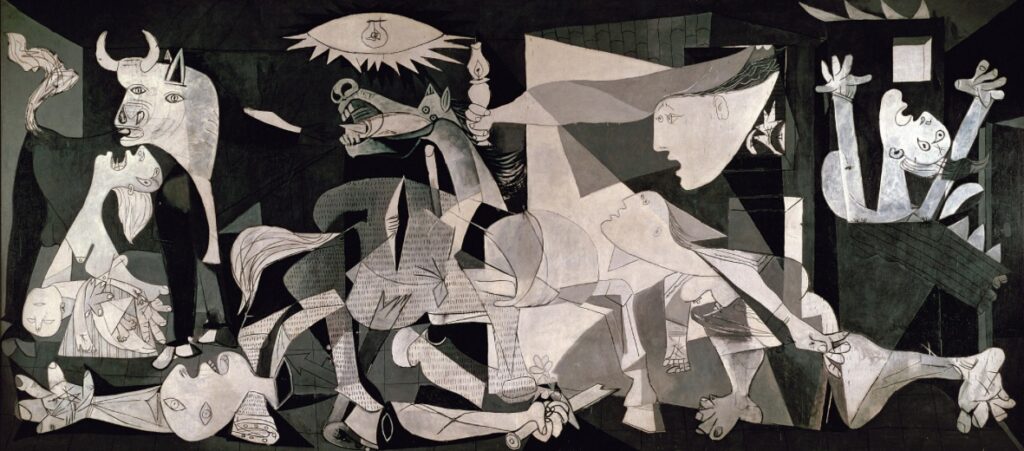
Picasso was securely affected past the horrors of the Spanish Ceremonious State of war, which had begun on 17 July 1936 when General Francisco Franco led a armed forces coup against the Spanish Republic.
Seven months afterwards, Franco's troops were in full control of the country. After visiting Barcelona in October 1936 and witnessing widespread devastation from heavy fighting, Picasso told his friend Joan Miró that he wanted to do something to evidence his anger.
He later wrote: "I'm going to paint something unbelievably huge… I'll practice it with all my rage." He began making sketches for the painting on ii December 1936.
Guernica has been described equally the artist'due south most powerful creation, and one of his few works on a truly epic scale.
The painting was created in response to the bombing of Guernica, a Basque Country town in northern Spain, by German planes commanded by Full general Franco during the Spanish Civil War. Information technology depicts the tragedy and suffering of state of war with startling ability.
The painting was completed by Picasso in 1937 and it has been considered to be ane of his nigh famous works. Information technology depicts the horrors of war, including violence and decease.
The painting does non depict whatsoever specific battle or outcome, only rather all of the events that transpired during war.
2. Les Demoiselles d'Avignon
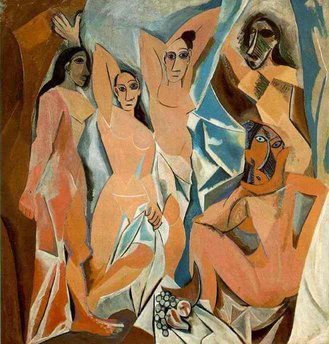
" Les Demoiselles d'Avignon" is considered to exist the first Cubist work of fine art. It is a painting created past Pablo Picasso in 1907. The painting was created during the pinnacle of his determinative Cubism catamenia and is one of the most of import pieces in the history of modern art.
Picasso arrived in Paris at a time when there were many artists creating new, innovative styles of artwork. For Picasso, this meant that he was not notwithstanding pigeonholed into i manner and could explore many avenues without much worry from critics or other artists.
This freedom gave him room to explore his creativity and experiment with different techniques and methods without feeling pressured to conform to what others were doing at the time.
The painting was created out of a mixture of styles that Picasso had been experimenting with during that period. Information technology was an important moment in his career as it helped him break through to brainchild and to mod art.
This painting is too significant because when it was debuted in public, it shocked many people and caused a lot of negative reactions because they were not used to such paintings at the time.
3. The Weeping Woman
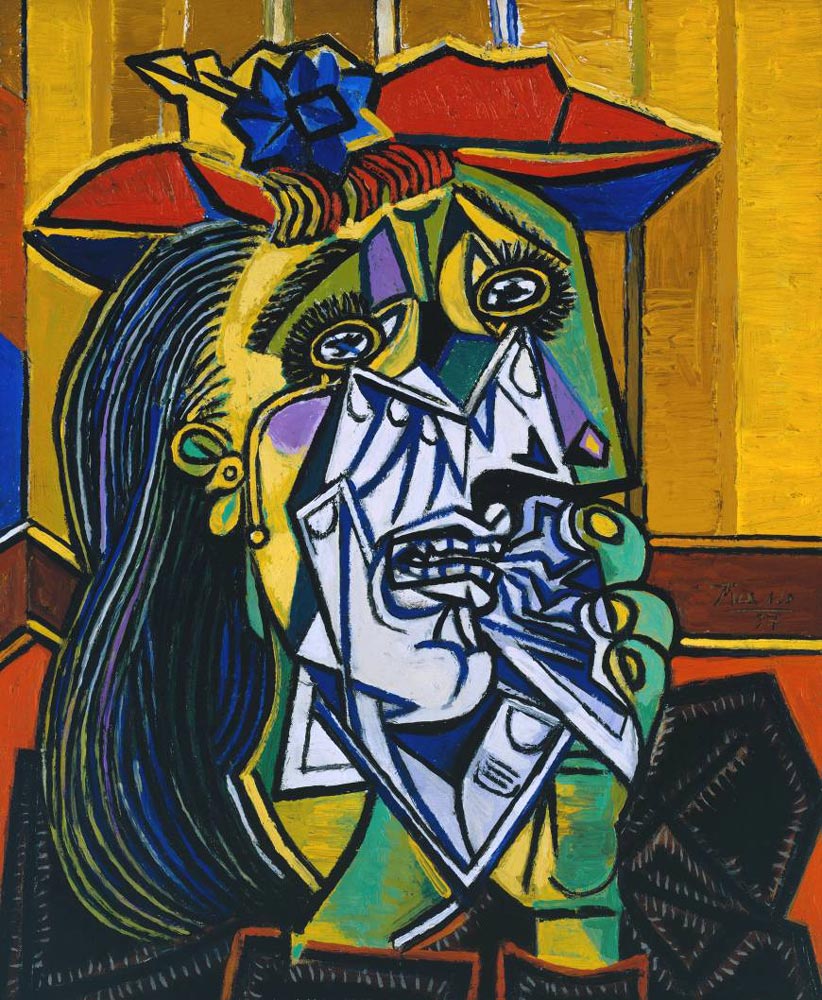
Pablo Picasso was well-known for his bizarre interpretations of dissimilar characters he painted. Afterward in his life, he started to paint in more vibrant hues in lodge to convey the emotional importance of the subject.
The Weeping Woman is an oil on sheet piece of work past Pablo Picasso that was completed in 1937 in France. Dora Maar, Picasso'south mistress and muse, is shown in the film.
Picasso'southward signature profile view of the woman's face appears in this piece, but other minor details hint to a higher degree of perspective for the viewer to perceive.
The piece is primarily concerned with the woman's face, which is shown in a diverseness of clashing colors and geometric forms. Picasso's utilize of subtle blue hues on her face below the optics, which seems to propose that her face up is covered in tears, emphasizes her high degree of emotional sorrow even more than.
"Weeping Woman" shows a distraught female weeping and belongings a handkerchief to her face to collect her profuse tears.
This universal picture of suffering is painted in the flattened fashion of Picasso's early analytical Cubism, which is distinguished past the use of angular and overlapping pieces of the subject's face, as if painted from many perspectives at the same time.
4. The One-time Guitarist
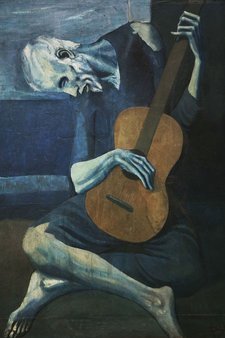
Picasso spent most of his life in extreme poverty, and information technology is claimed that during this flow he developed a strong sympathy with the world's impoverished and oppressed.
The One-time Guitarist was created in 1903, during a menstruum when Picasso was believed to be almost broke while living in Barcelona.
This time has been dubbed his 'Blue' phase, when he painted nearly every canvas in a drab monochromatic palette of blueish, a hue that matched the kind of subject matter that he would accost.
Picasso created this piece soon after his shut friend Casagemas committed suicide every bit a result of a lengthy battle with mental illness and despair.
The creative person dedicated this slice, every bit well equally others during this fourth dimension menses, to concentrating on people who are often oppressed and burdened by the concerns and bug that so often consume humanity.
Because the whole piece of work is washed in a deep blue colour, the painting conveys a stiff feeling of desolation to the spectator.
The human in the picture is holding a guitar and seems to be playing a sorrowful song, his confront set with desperation and despair.
Picasso'southward fantabulous apply of the color blue, art critics and historians have observed, correctly imposes the feeling of melancholy that and then many people experience in this piece.
The guitar is a intermission in the monochromatic blue's subdued near flat, two-dimensional shapes, while the musician seems slumped down and sad.
Subsequent 10-rays of the artwork showed the presence of a ghostly effigy (a lady) that Picasso had begun to pigment but and then changed his listen and chose to paint over her.
5. Cocky-Portrait 1901
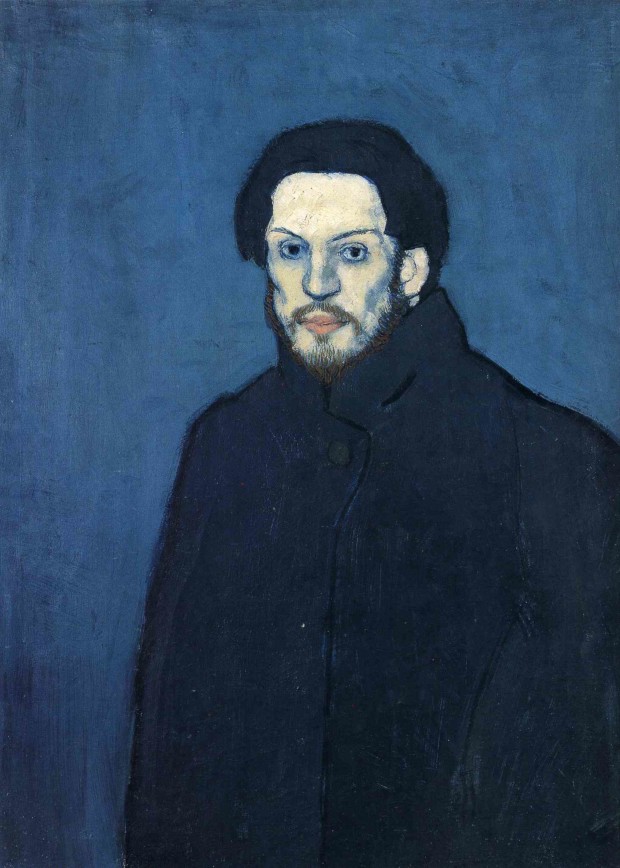
Picasso was quite young in this famous self-portrait and was only xx at the time, yet he looks much older in this picture show. His face up looks drawn and haggard as a result of the hard winter in Paris living a very downtrodden life.
He had just recently arrived in Paris and had yet to plant whatever meaningful friendships when he created this piece soon after the suicide of his friend Carlos Casagemas.
The death hit him difficult and had a serious effect on his mental health.
This self-portrait is non Picasso'due south first, but it is one of the earliest works of the Blue Period.
6. Girl before a Mirror
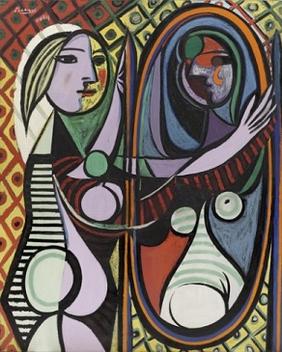
Pablo Picasso produced Girl before a Mirror in 1932 as an oil on canvas painting. The moving-picture show depicts Picasso'southward mistress and muse, Marie-Thérèse Walter, continuing in front of a mirror, gazing at her reflection.
During the 1930s, Picasso painted Marie-Thérèse many times. His pictures of her from 1932 were the first public exhibition of their secret romance during his marriage to Olga Khokhlova.
Picasso'due south creative career was shaped past the year 1932. He had reached the age of 50 at this indicate in his life and had established himself as a pregnant artist.
Picasso was the curator of a retrospective prove of his work at Galerie Georges Petit in 1932, which was an uncommon occurrence for an artist, and even more unexpectedly, Picasso seized charge of the curating.
Girl before a Mirror is a photograph of a lady gazing in a mirror, revealing a darker reflection of herself. The woman'due south face has been divide into 2 parts, one of which is painted in a peaceful, lilac color, and the other in a vibrant, yellow hue.
The reflection depicts the subject area in a dissimilar light, making her seem older and with a sunken face, perhaps as a symbol of her decease.
7. La Vie
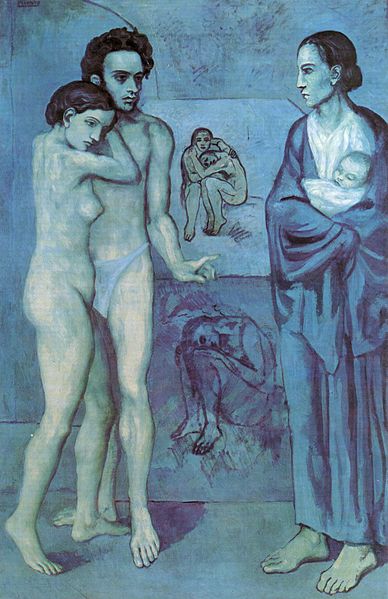
La Vie (The Life) is an oil on sail work that was completed in May 1903 in Barcelona.
It is mostly considered as the peak of Picasso's Blueish Period'due south. Nonetheless, at the time he was a 22-year-sometime unknown creative person who had yet to make his affect on the world of art.
The interpretation of the mysterious limerick has sparked considerable debate. One thing is articulate is that information technology is Picasso's homage to his close friend Carlos Casagemas who had committed suicide.
Picasso's business organization with life and death is completely represented in its somber mood.
8. Ma Jolie
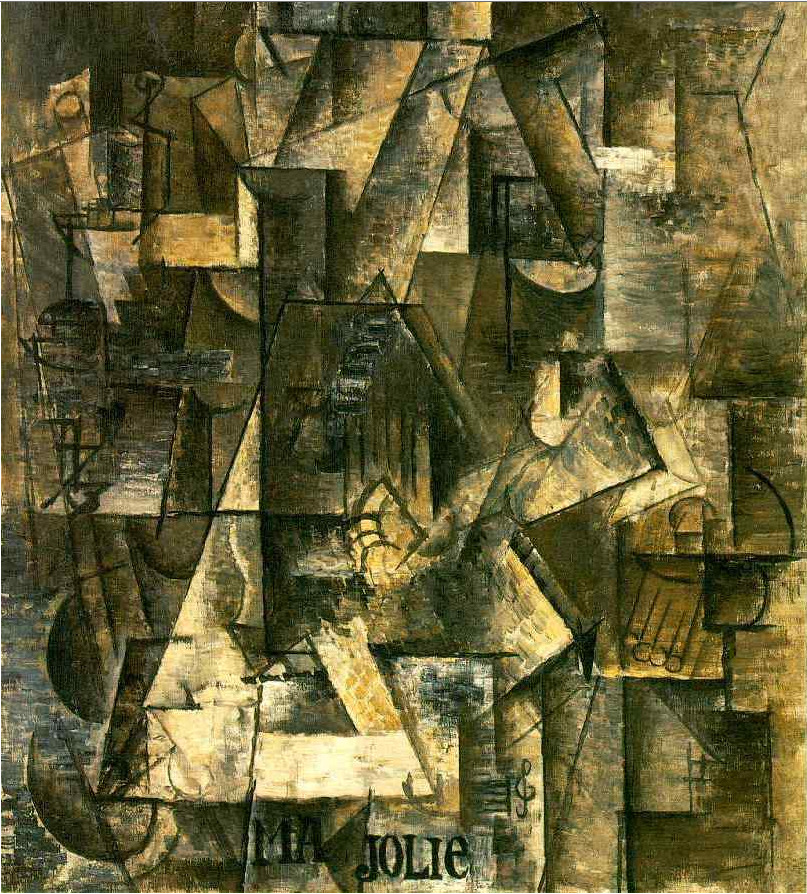
Picasso'south 1911 painting, Ma Jolie, openly portrays his girlfriend, Marcelle Humbert.
Picasso claimed Ma Jolie, which ways "my beautiful 1," was a reference to a famous music-hall vocal from the fourth dimension, only the real meaning was kept hidden, known just to those shut to his circle of acquaintances.
Every bit the master image fades into the depths of abstract surfaces and tiny details, the irregular forms and dark, brackish hues seem to communicate a deeper bulletin.
Marcelle Humbert's figure is synthetic in a haphazard fashion utilizing Analytic Cubism'south characteristic changing planes.
The vi strings in the eye of the paradigm are a reference to the guitar, while the triangle on the right seems to correspond the woman's elbow.
9. Three Musicians
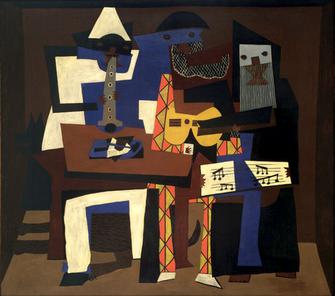
Three Musicians is the title of two collage and oil works by Picasso . Both were finished in 1921 in Fontainebleau, France, near Paris, and are fantabulous examples of the Constructed Cubist way.
Each artwork depicts a Harlequin, a Pierrot, and a monk, who are said to be Picasso, Guillaume Apollinaire, and Max Jacob, respectively.
The Harlequin playing a guitar in the middle is a recurrent stand-in for Picasso himself throughout his piece of work. Pierrot and Harlequin are standard figures from the aboriginal Italian comedy theater known as Commedia dell'Arte, which is a recurring subject throughout Picasso's work.
Three Musicians seems to be a collage created from cut out pieces of colorful newspaper, despite the fact that it is an oil painting. The forms are reduced to angular patterns that interlock like jigsaw puzzles.
Three Musicians is part of a major change in Picasso's work that happened later on 1914. Picasso created just a few collages after 1914. Instead, he used Cubist techniques in the conventional medium of oil on canvas, allowing him to produce considerably bigger and more colorful works.
This new technique had a major advantage: oil paintings could exist sold at much greater prices than collages.
ten. Portrait of Gertrude Stein
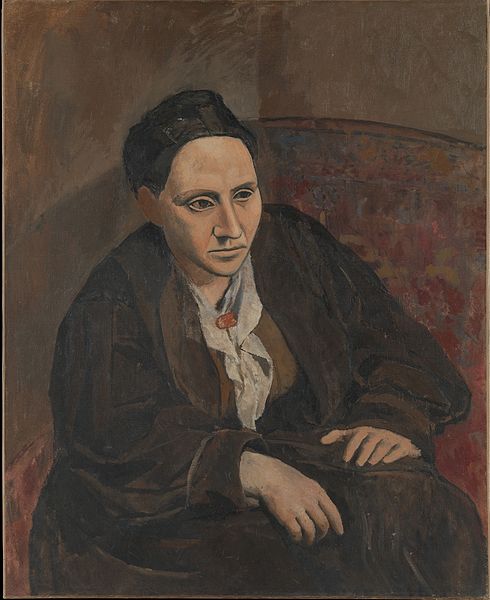
Portrait of Gertrude Stein is an oil on sheet portrait of the American author and fine art collector Gertrude Stein. Picasso began working on the painting in 1905, merely it was non completed until the following year.
It is regarded as one of Picasso's most significant paintings from his Rose Period.
The moving picture exemplifies the geometric distortions and formal experiments that would come to define his work after the advent of Cubism.
Picasso's artwork defied conventional portraiture conventions past portraying the subject as a huge, hulking figure staring blankly across the picture rather than at the spectator. Her figure is a round bulk, and she leans forward, her artillery weightily resting on her knees.
This stylistic shift proved to be of enormous historical significance since it indicated the path Picasso would take step past stride until the creation of cubism.
Source: https://www.artst.org/picasso-paintings/
0 Response to "10 Most Famous Picasso Paintings"
Post a Comment